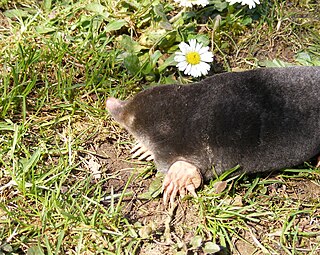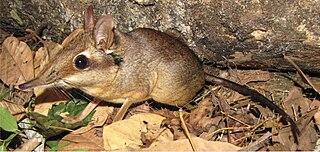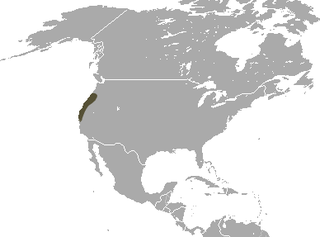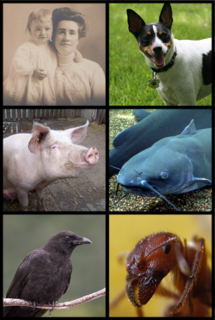Vermivore Is A Zoological Term For Animals That Eat What?
Vermivore
Last updated
Vermivore (from Latin vermi, significant "worm" and vorare, "to devour") is a zoological term for animals that eat worms (including annelids, nematodes, and other worm-like animals). [1] Animals with such a diet are known to be vermivorous. [2] Some definitions are less exclusive with respect to the diet, but limit the definition to detail animals, e.g. "Feeding on worms or insect vermin. Used of a bird." [3]
- Examples
- Come across as well
- References
An unabridged genus of New World warblers has been given the proper name Vermivora .
I vermivore that may feed exclusively on worms is Paucidentomys vermidax , a rodent species of a type usually known equally shrew rats which was discovered in 2011 in Indonesia. The name, which tin exist translated equally "worm-eating, few-toothed mouse", refers to the fact that they have only four teeth and may alive exclusively on a diet of earthworms. [4] This reduced dentition in vermivorous mammals is said to be due to relaxed selectional pressure level on dental occlusion. [5]
Examples
- Shrews
- Tuataras
- Hedgehogs
- Kiwi
- Long-beaked echidna [vi]
- Platypus
- Woodcocks
- Leeches of the genus Americobdella
- Moles [ citation needed ]
- American robins
- Wormsnakes
- Some bounding main snails e.m. Jaspidiconus and Conus species.
See as well
- Carnivore
- Frugivore
- Plant eater
- Insectivore
- List of feeding behaviours
- Nectarivore
- Omnivore
Related Research Manufactures

A carnivore, significant "meat eater", is an creature whose food and free energy requirements derive solely from animate being products whether through hunting or scavenging. Animals that depend solely on beast flesh for their nutrient requirements are called hypercarnivores or obligate carnivores, while those that also consume not-beast food are called mesocarnivores or facultative carnivores. Omnivores too consume both animal and not-creature food, and autonomously from the more than general definition, at that place is no clearly defined ratio of found vs. animal material that would distinguish a facultative carnivore from an omnivore. A carnivore at the top of the food chain, not preyed upon by other animals, is termed an noon predator.

Coprophagia or coprophagy is the consumption of feces. The word is derived from the Ancient Greek: κόπρος copros, "feces" and φαγεῖν phagein, "to swallow". Coprophagy refers to many kinds of carrion-eating, including eating feces of other species (heterospecifics), of other individuals (allocoprophagy), or ane'southward own (autocoprophagy) – those once deposited or taken directly from the anus.

The treeshrews are small mammals native to the tropical forests of South and Southeast Asia. They brand up the entire order Scandentia, which divide into two families: the Tupaiidae, and the Ptilocercidae.

Moles are small-scale mammals adapted to a subterranean lifestyle. They take cylindrical bodies, velvety fur, very small, inconspicuous optics and ears, reduced hindlimbs, and short, powerful forelimbs with big paws adapted for digging.

Shrews are minor mole-like mammals classified in the guild Eulipotyphla. True shrews are not to be dislocated with treeshrews, otter shrews, elephant shrews, West Indies shrews, or marsupial shrews, which vest to dissimilar families or orders.

Elephant shrews, also called jumping shrews or sengis, are minor insectivorous mammals native to Africa, belonging to the family Macroscelididae, in the club Macroscelidea. Their traditional mutual English proper name "elephant shrew" comes from a perceived resemblance betwixt their long noses and the body of an elephant, and their superficial similarity with shrews in the social club Eulipotyphla. However, phylogenetic analysis revealed that elephant shrews are not classified with true shrews, but are in fact more than closely related to elephants than shrews. In 1997, the biologist Jonathan Kingdon proposed that they instead be chosen "sengis", a term derived from the Bantu languages of Africa, and in 1998, they were classified into the new clade Afrotheria.

A tenrec is whatsoever species of mammal within the afrotherian family Tenrecidae endemic to Madagascar. Tenrecs are widely diverse; as a result of convergent evolution some resemble hedgehogs, shrews, opossums, rats, or mice. They occupy aquatic, arboreal, terrestrial and fossorial environments. Some of these species, including the greater hedgehog tenrec, can exist found in the Madagascar dry deciduous forests. Notwithstanding, the speciation rate in this group has been higher in boiling forests.

The American pygmy shrew is a pocket-sized shrew constitute in Northern Alaska, Canada, and the northern United States, south through the Appalachian Mountains. Information technology was commencement discovered in 1831 by naturalist William Cane in Georgian Bay, Parry Sound.

The marsh shrew, also known as the Pacific water shrew, Bendire's water shrew, Bendire's shrew and Jesus shrew is the largest N American member of the genus Sorex. Primarily covered in chocolate-brown fur, information technology is plant virtually aquatic habitats forth the Pacific coast from southern British Columbia to northern California. With air trapped in its fur for buoyancy, marsh shrews can run for three to five seconds on top of the water. It measures nearly 16 cm (half-dozen.3 in) in length, including a 7-centimetre (ii.8 in)-long tail, and weighs an boilerplate of 14.5–16 g (0.51–0.56 oz). The marsh shrew's diet consists mainly of invertebrates, which information technology hunts on land and in the water. They are rare; their populations are thought to be in refuse, and they are considered endangered in parts of their range.

The lesser white-toothed shrew is a tiny shrew with a widespread distribution in Africa, Asia and Europe. Its preferred habitat is scrub and gardens and it feeds on insects, arachnids, worms, gastropods, newts and small rodents, though its diet usually varies according to the biotope where it lives. The closely related Asian bottom white-toothed shrew was in one case included in this species, only is at present considered to be a separate species.

Aquatic and semiaquatic mammals are a various group of mammals that dwell partly or entirely in bodies of water. They include the diverse marine mammals who dwell in oceans, equally well as various freshwater species, such as the European otter. They are non a taxon and are not unified by any distinct biological grouping, but rather their dependence on and integral relation to aquatic ecosystems. The level of dependence on aquatic life varies greatly amid species. Among freshwater taxa, the Amazonian manatee and river dolphins are completely aquatic and fully dependent on aquatic ecosystems. Semiaquatic freshwater taxa include the Baikal seal, which feeds underwater just rests, molts, and breeds on country; and the capybara and hippopotamus which are able to venture in and out of water in search of food.

The 4-toed elephant shrew or four-toed sengi is the only living species in the genus Petrodromus , which together with five other extant genera Rhynchocyon, Macroscelides, Petrosaltator, Galegeeska and Elephantulus constitutes the order Macroscelidea. This species is but found in particular regions in Africa and is smaller in size compared to its relatives. A comprehensive recording of this species is lacking.

Crocidura grandiceps is a species of mammal in the family Soricidae. It is plant in Benin, Ivory coast, Ghana, Guinea, Republic of liberia, Nigeria, and Togo. Its natural habitat is subtropical or tropical moist lowland forests. It is threatened by habitat loss due to agriculture and aquaculture as well as logging and forest harvesting. To increase habitat protection for the C. grandiceps, in-identify state/water protection conservation actions are in place. The colloquial name big-headed shrew is sometimes practical to C. grandiceps but has also been used for the entire related genus Paracrocidura. The IUCN List categorizes the C. grandiceps equally Near Threatened equally of 2008.

The forest shrew is a species of shrew in the mouse shrew family unit, Soricidae. It is found in Lesotho, South Africa, and Eswatini. Its natural habitats include temperate forests, dry savanna, Mediterranean-type shrubby vegetation, and temperate grassland. The term "forest shrews" in the plural is sometimes confusingly used to collectively refer to a different genus, Sylvisorex.

The fog shrew is a species of mammal in the family unit Soricidae. Information technology is endemic to northern California and Oregon in the United states.

Trowbridge'due south shrew is a species of mammal in the family Soricidae. Information technology is establish in southern British Columbia in Canada and in Washington, Oregon, and California in the United States.

Myrmecophagy is a feeding beliefs defined by the consumption of termites or ants, especially as pertaining to those animal species whose diets are largely or exclusively composed of said insect types. Literally, myrmecophagy means "ant eating" rather than "termite eating". All the same, the 2 habits often overlap, as both of these eusocial insect types often live in big, densely populated nests requiring similar adaptations in the creature species that exploit them.

An omnivore is an animal that has the ability to eat and survive on both plant and animal matter. Obtaining energy and nutrients from plant and animal thing, omnivores digest carbohydrates, protein, fat, and cobweb, and metabolize the nutrients and energy of the sources absorbed. Oftentimes, they have the ability to incorporate nutrient sources such as algae, fungi, and bacteria into their nutrition.

Paucidentomys is a genus of rodents of a type normally known equally shrew-rats which was discovered in 2012 in a remote rainforest on the Indonesian isle, Sulawesi. The genus is monotypic, consisting of the species Paucidentomys vermidax . The name, which is Latin and may be translated as "worm-eating few-toothed mouse", refers to the fact that they accept but two teeth and may alive exclusively on a nutrition of earthworms.
References
- ↑ "Animal Diversity Spider web" . Retrieved 30 August 2012.
- ↑ Croker, Temple H. (1766). "Vermivorous". The Complete Lexicon of Arts and Sciences. 3.
- ↑ "The Costless Dictionary" . Retrieved 30 August 2012.
- ↑ Esselstyn, J.A., Achmadi, A.S. Rowe, K.C. (2012). Evolutionary novelty in a rat with no molars. Biological science Messages, published online 22 Baronial 2012, doi : x.1098/rsbl.2012.0574
- ↑ Charles, Cyril; Solé, Floréal; Rodrigues, Helder Gomes; Viriot, Laurent (2013-06-01). "Under Force per unit area? Dental Adaptations to Termitophagy and Vermivory Amid Mammals". Evolution. 67 (six): 1792–1804. doi: 10.1111/evo.12051 . ISSN 1558-5646. PMID 23730770.
- ↑ "Spiny Anteaters: Licking Up Its Nutrient". International Wild animals Encyclopedia. 18. Marshall Cavendish. 2002. p.2488. (subscription required)
This page is based on this Wikipedia article
Text is available under the CC BY-SA 4.0 license; additional terms may apply.
Images, videos and audio are available under their respective licenses.
Source: https://wikimili.com/en/Vermivore
Posted by: quinnsprome.blogspot.com

0 Response to "Vermivore Is A Zoological Term For Animals That Eat What?"
Post a Comment